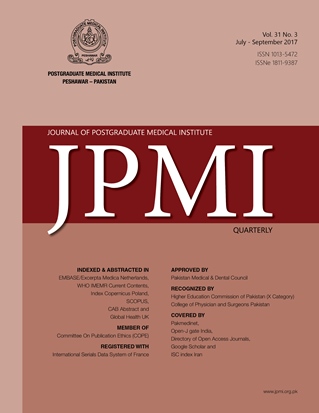COMPASSION SATISFACTION, SECONDARY TRAUMATIC STRESS AND BURNOUT AMONG RESCUERS
Main Article Content
Abstract
Objective: To explore the level of and relationship between compassion satisfaction
(CS), secondary traumatic stress (STS), and burnout (BO) and to find out
significant predictors of compassion satisfaction among rescuers.
Methodology: This study was based on cross-sectional survey research design.
It was conducted in Faisalabad Division from September to December 2016. A
sample of 185 men with mean age 32.45 ±5.64 paramedics (n=100) and firefighters (n=85) working in Rescue 1122 were selected with purposive sampling
technique from Faisalabad and Chiniot City. Professional Quality of Life scale
developed by Stamm (2009) was used to measure the level of CS, STS and BO
among paramedics and fire fighters.
Results: Significant positive relationship between CS and STS and significant
negative relationship between CS and BO among rescuers were observed (p
<0.01). Rescuers' have moderate level of CS, STS and BO. Compassion satisfaction was significantly predicted from age group, marital status, living area,
socioeconomic status, nature of job, STS and BO (F [7,177] =44.37, p =.001) R2
=.64.
Conclusion: Rescuers had average level of and significant relationship with
CS, STS, and BO. Compassion satisfaction was significantly predicted from age
group, marital status, living area, and socioeconomic status, nature of job, STS
and BO.
(CS), secondary traumatic stress (STS), and burnout (BO) and to find out
significant predictors of compassion satisfaction among rescuers.
Methodology: This study was based on cross-sectional survey research design.
It was conducted in Faisalabad Division from September to December 2016. A
sample of 185 men with mean age 32.45 ±5.64 paramedics (n=100) and firefighters (n=85) working in Rescue 1122 were selected with purposive sampling
technique from Faisalabad and Chiniot City. Professional Quality of Life scale
developed by Stamm (2009) was used to measure the level of CS, STS and BO
among paramedics and fire fighters.
Results: Significant positive relationship between CS and STS and significant
negative relationship between CS and BO among rescuers were observed (p
<0.01). Rescuers' have moderate level of CS, STS and BO. Compassion satisfaction was significantly predicted from age group, marital status, living area,
socioeconomic status, nature of job, STS and BO (F [7,177] =44.37, p =.001) R2
=.64.
Conclusion: Rescuers had average level of and significant relationship with
CS, STS, and BO. Compassion satisfaction was significantly predicted from age
group, marital status, living area, and socioeconomic status, nature of job, STS
and BO.
Article Details
How to Cite
1.
Zaidi SMIH, Yaqoob N, Saeed H. COMPASSION SATISFACTION, SECONDARY TRAUMATIC STRESS AND BURNOUT AMONG RESCUERS. J Postgrad Med Inst [Internet]. 2017 Aug. 10 [cited 2025 Dec. 5];31(3). Available from: https://jpmi.org.pk/index.php/jpmi/article/view/2137
Issue
Section
Original Article
Work published in JPMI is licensed under a
Creative Commons Attribution-NonCommercial 2.0 Generic License.
Authors are permitted and encouraged to post their work online (e.g., in institutional repositories or on their website) prior to and during the submission process, as it can lead to productive exchanges, as well as earlier and greater citation of published work.


